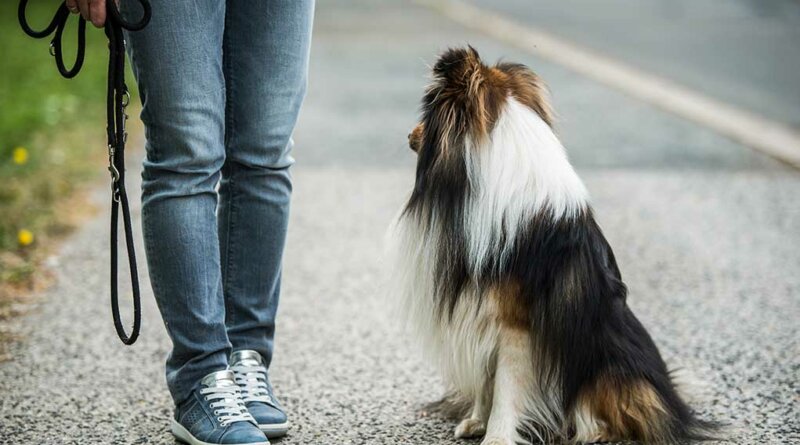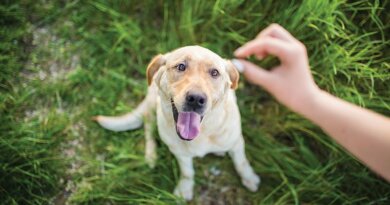Why Not to Walk A Dog Without a Leash – Top Dog Tips
We all know that dogs need plenty of exercises, especially if you own a high-energy breed.
Going for walks is just one form of activity that can burn those extra bursts of energy.
But, for some dog owners, the desire to let their dog roam free while on walks may seem like a decent idea.
This is especially true if your dog seems to have a decent handle on training and commands (especially heel and recalling back to you on command).
Unfortunately, it’s not always the best idea to walk a dog without a leash.
Here are a few reasons to keep your dog leashed on walks, even if your dog is a great listener.
To Walk a Dog Without a Leash is Not Street Safe
There is nothing more devastating to a pet owner than watching a beloved pet get hit by a moving vehicle.
Busy intersections, roads, parking lots, and roadsides are high-risk areas for your dog.
That’s because many drivers aren’t looking for smaller, unexpected items while driving, including your dog.
There are many reasons your well-behaved companion may dart into the street, chasing a scent or small animal, fear or anxiety of new environments, or curiosity.
The risk isn’t worth it; always leash your pets near a street or vehicle path.
Try to remember that having a leash will keep your dog close to your side and out of harm’s way, particularly if you have a hound or hunting dog.
It’s Better Etiquette and Greetings When You Don’t Walk a Dog Without a Leash.
Dogs are social animals by nature. They enjoy spending time playing, greeting, and meeting other dogs on walks.
This greeting can get quite “rude” with jumping, rough-housing, and otherwise aggressive behavior for some dogs.
To limit the chance of a greeting turning sour, it’s important to introduce any dogs to one another in a controlled environment.
The leash offers a tether to its owner, which can significantly control the interactions between two dogs.
Most dogs introduced on a leash will smell each other, wag their tails, and possibly play for a few moments.
It also offers an immediate response to any aggressive behavior. Walk away from a greeting if you notice an unfavorable response between the two dogs.
To Walk a Dog Without a Leash Can Provoked Attacks
While your dog may be the most friendly, sweet, and courteous dog, other dogs do not have the same temperament.
In fact, reactive dogs, aggressive dogs, and those suffering from anxiety can all see an unleashed dog approaching as a direct threat.
This response can lead to many escalated situations, even if your dog isn’t naturally inclined to attack or bite.
Further, if a dog fight were to happen between the two dogs, the unleashed dog will always take the onus as instigator (particularly if vet bills or animal control are at stake) because you failed to control your dog.
Keeping control of your dog is as simple as keeping him leashed.
Not Everyone Loves Your Dog, So Don’t Walk a Dog Without a Leash.
Yes, we are naturally smitten with our furry companion, but the majority of people aren’t going to appreciate a strange dog running at them without notice.
Approaching strangers also puts your dog at risk—as some may not react warmly or kindly to being approached.
They may scream, hit, or kick your dog as he approaches. This is especially true for senior citizens, children, or those with a fear of dogs.
While no one should be allowed to hurt an animal, people are allowed to protect themselves from a potential threat (like your unknown dog) in a reasonable manner… including physical force.
If you’re walking through a public area, always keep your dog leashed to avoid potential problems.
When You Walk a Dog Without a Leash, It’s Hard to Avoid the Wildlife
When most people consider threats to a dog, they think of large animals like coyotes, foxes, and bears.
Unfortunately, those aren’t the biggest threats to an unleashed dog. Smaller animals like raccoons, bats, and skunks can all be carriers of disease—including rabies. Rabies currently has no cure and is almost always fatal.
Infected animals typically die within five days of contracting the disease. Because the rabies infection is secreted in saliva, they transfer from a bite wound between the infected animal and your dog.
To save yourself the heartache, keep your dog on a leash when on walks.
This is particularly true for times surrounding dusk or dawn when nocturnal animals are most likely to be awake.
Prevent Accidental Damage or Trespassing
If you are out on a walk, keeping your dog leashed is the easiest way to avoid potential problems.
Although you may not have an issue with random dogs walking across your property, others may not feel the same.
Dog urine can kill patches of grass quickly, especially when dogs repeatedly use the same area.
Likewise, a nosey dog can knock over expensive planters, knick-knacks, statues, or damage flowers.
It’s always better to keep your dog close when walking through neighborhoods or private property, especially if your pup is rambunctious.
Limit Baths and Grooming Times
Mud, burrs, and dust can cause dog owners huge problems, especially when out on trails or hikes.
Letting your dog roam free will often have them travel off the path instead of staying in the clearing.
Burrs (prickly bushes that often stick to fur and can form mats and tangles in a dog’s fur) can be difficult and painful to remove.
Likewise, unexpected puddles, mud, and dirt can make for an unexpected grooming session.
Caked on mud can definitely be a lot of fun for your furry friend but can quickly make a massive mess in your vehicle and home.
Less Likely to Get Lost on the Way
All it takes is one incredible scent or a stray cat for your dog to begin the chase, leaving you scrambling to find him after the fact.
Some dogs could travel miles away from home following a scent, making the likelihood of finding him if he were to get lost even lower.
By having your dog attached to a leash, you’ll be able to interrupt any instinct to bolt after something truly irresistible.
Lowering the Pet Population
While this may only apply to intact males and females, having your dog on a leash is the easiest way to prevent accidental pregnancy.
Spaying or neutering your dog is always the best option from a population standpoint, but if you haven’t done that –always keep your pet on a leash when out for walks.
Limit High-Risk Items That Could Harm Them
Dogs are curious and inquisitive by nature, exploring the world with their nose and with their mouth daily.
Pesticides, animal droppings, poisons, pest control products, or food scraps can all make your dog sick if ingested.
On a leash, it’s easier to monitor and control what your canine has access to (both in terms of food and scents), reducing the risk they’re going to get sick after eating something on the walk.
Garbage bags and tins can pose a huge temptation to pups, with plenty of dangerous items, regardless of spoiled food.
A fermented food, pests, bones, and other choking hazards can cause significant and deadly issues.
Not to mention the costly veterinarian bills which can occur should your pet require treatment.
You Don’t Establish Dominance When You Walk a Dog Without a Leash.
As dogs are pack animals, they will quickly try to determine who is leading the pack.
Having your dog on a leash (or tied to you) controls where your dog can go and how far ahead (or beside you completely) he can venture.
Additionally, your dog is forced to follow your pace, direction, and objectives instead of having his own.
By staying in control of your dog, you’re effectively telling him that you’re the pack leader and that he can stand down and follow the group.
Less Stress for Both of You
Walking around your block is fantastic exercise, but if you do not have to worry about where your dog is at all times, chances are you’ll enjoy the activity more.
If you’re looking for a higher level of physical activity for your dog, consider wearing inline skates or using your bike. You’ll both be able to raise your heartbeat without the risk of getting lost or injured.
Just be sure always to use a nylon harness when bringing your dog along for a jog, run, bike ride, or inline skate.
This will lower the pressure on his neck if he pulls ahead or needs to be redirected.
It’s Probably Against The Law to Walk a Dog Without a Leash
Majorities of cities, municipalities, and regions have their own distinct laws and guidelines regarding dog ownership and leash laws.
These laws are not open for interpretation; they are expected to be followed by every resident or face steep (read, expensive) fines.
If you’re unsure of your city’s rules or by-laws, visit your city website.
Acceptable Leash-Free Locations to Play with Your Dog
Sometimes it’s hard to have a dog on a leash constantly. Many breeds require large quantities of activity each day, and walking doesn’t always cut it.
If you’re looking to provide a safe and comfortable environment for your dog, consider looking for leash-free areas.
A leash-free area is a dog-friendly park that allows your dog to be off the leash while remaining safe.
Normally, leash-free areas will be fully fenced in (although these fences may not be high enough to contain spirited jumpers).
If visiting a leash-free park, always make sure your dog is current on all vaccines.
Some diseases and conditions can be passed between close contact at dog parks, making vaccination your easiest defense line.
Leash-Free Designated Dog Parks
Most cities will contain a fenced-in area for dogs to run off-leash.
Leash-free parks are freely accessible to residents wanting to let their dog roam, but it’s still important to always supervise your dog while in the park.
Foreign objects, poison, or dog feces can all post problems for your furry friend.
It’s also important to remember that not every dog behaves the same way at the park. Some may be quite shy and timid, whereas others may prefer the company of loud and rambunctious playmates. If your dog lacks basic manners, you may find him on the receiving end of a few nips from other dogs.
Always walk the dog park to inspect it for any dangerous or damaged items.
By walking through the park, you’ll give your dog the chance to explore the area with you while also getting a better understanding of the park itself.
Many dogs are shy or timid the first few times they attend a dog park but can quickly grow accustomed to playing with the other dogs.
Leash-free parks provide physical activity and provide socialization for both young and old dogs, provided the owners monitor the interactions.
If you notice any bullying from other dogs, it may be wise to avoid the park at that time of day and try again later.
Leash-Free Dog Beaches
Admittedly less common are leash-free areas designated to a lake, beach, or waterfront.
Swimming is a wonderful physical activity, working the entire body while cooling down too.
Always make sure that the area you’re in is both leash-free and dog-friendly.
Private property is not an acceptable location for your dog to run around without permission.
Make sure to pick up any accidents your dog may have in the sand.
You don’t want to have any animal feces go into the water, which can spread germs and bacteria throughout the beach (including any with public access).
Private Property
If you happen to own land or a large parcel of property, that would be the perfect area to let your dog roam free. While you’ll still have to be mindful of wild animals and environmental issues, you’ll be less likely to encounter vehicle or dog hazards.
Make sure your dog has a recall command in place before letting him roam free.
You can also try your hand at dog agility by having a few obstacles like balance beams, tunnels, or planks installed in the area for an extra challenge.
Dogs crave mental stimulation as well as physical exercise; by combining both, you’ll be more likely to tire out your pup.
Read Next: How to Train a Dog to Walk on a Leash














Cytotec 200mcg price https://cytotec24.com/ buy cytotec online